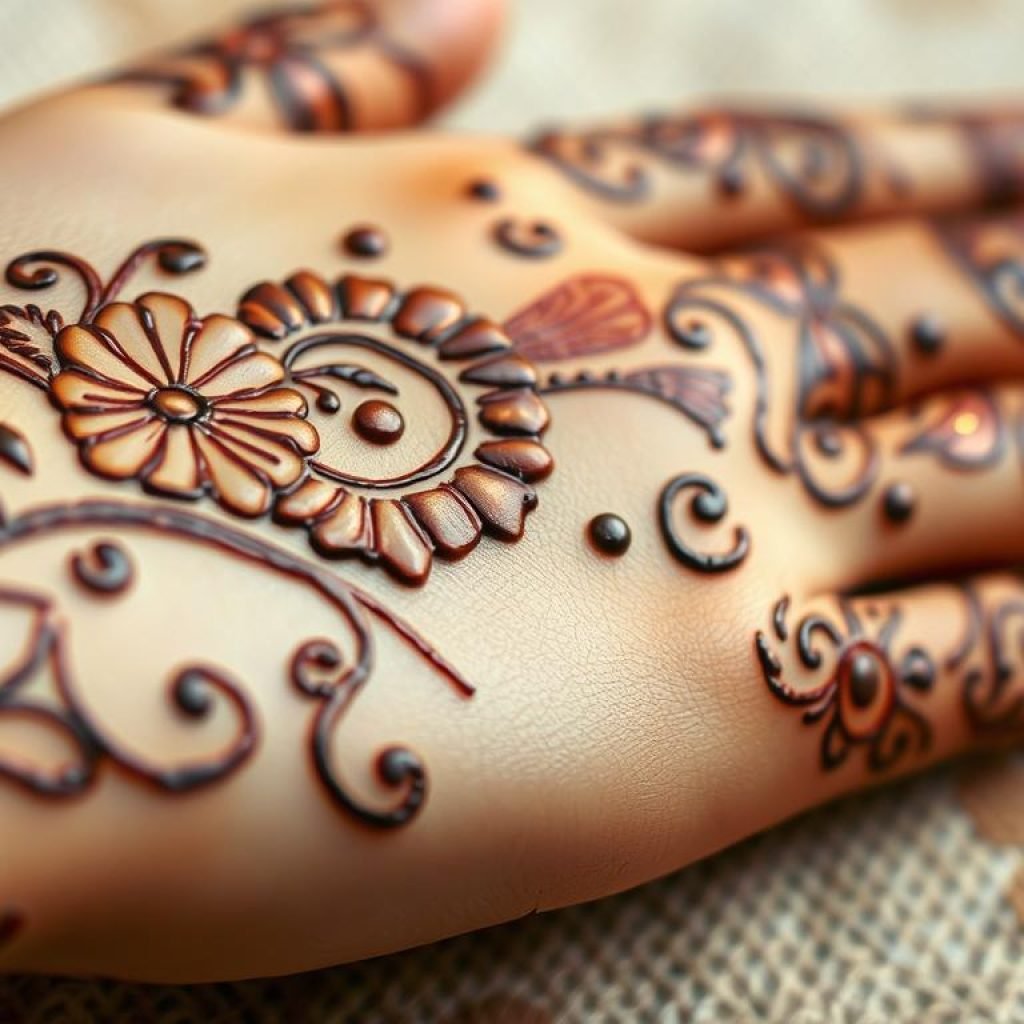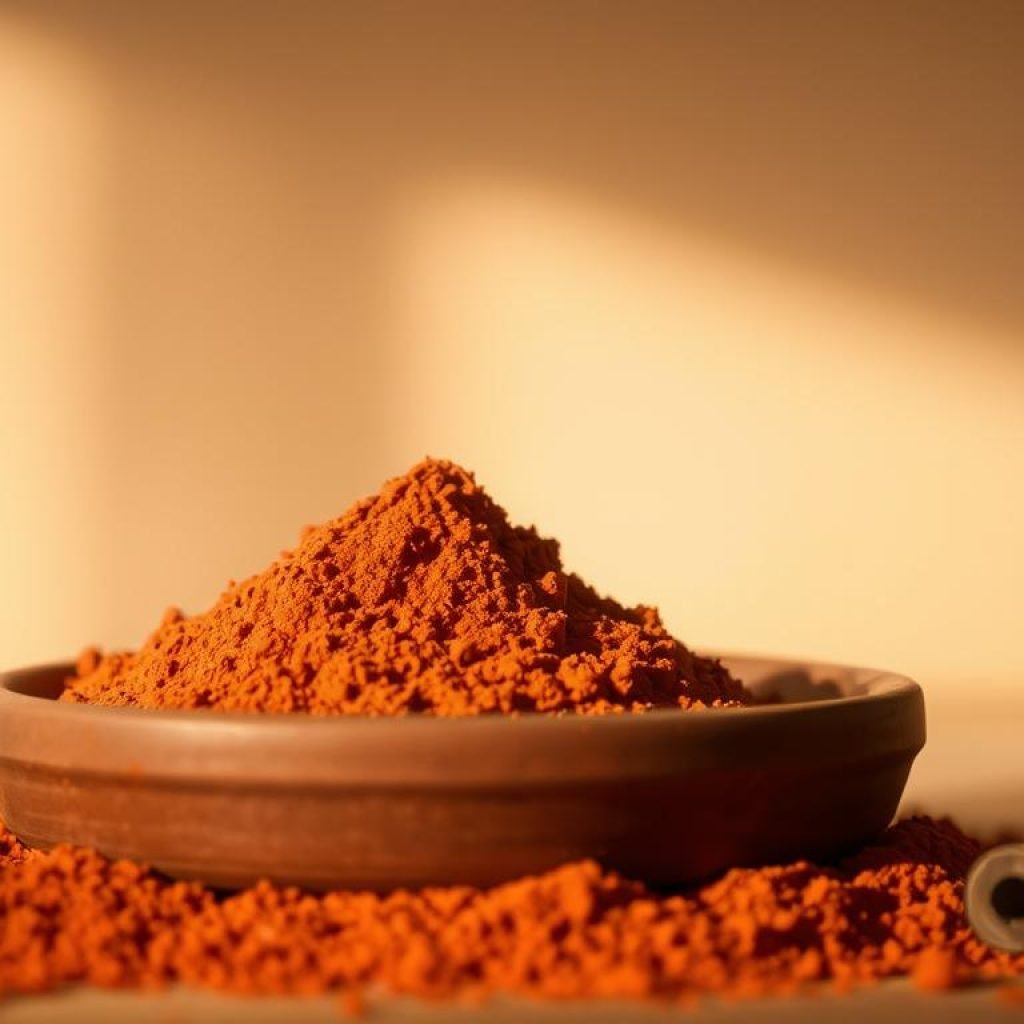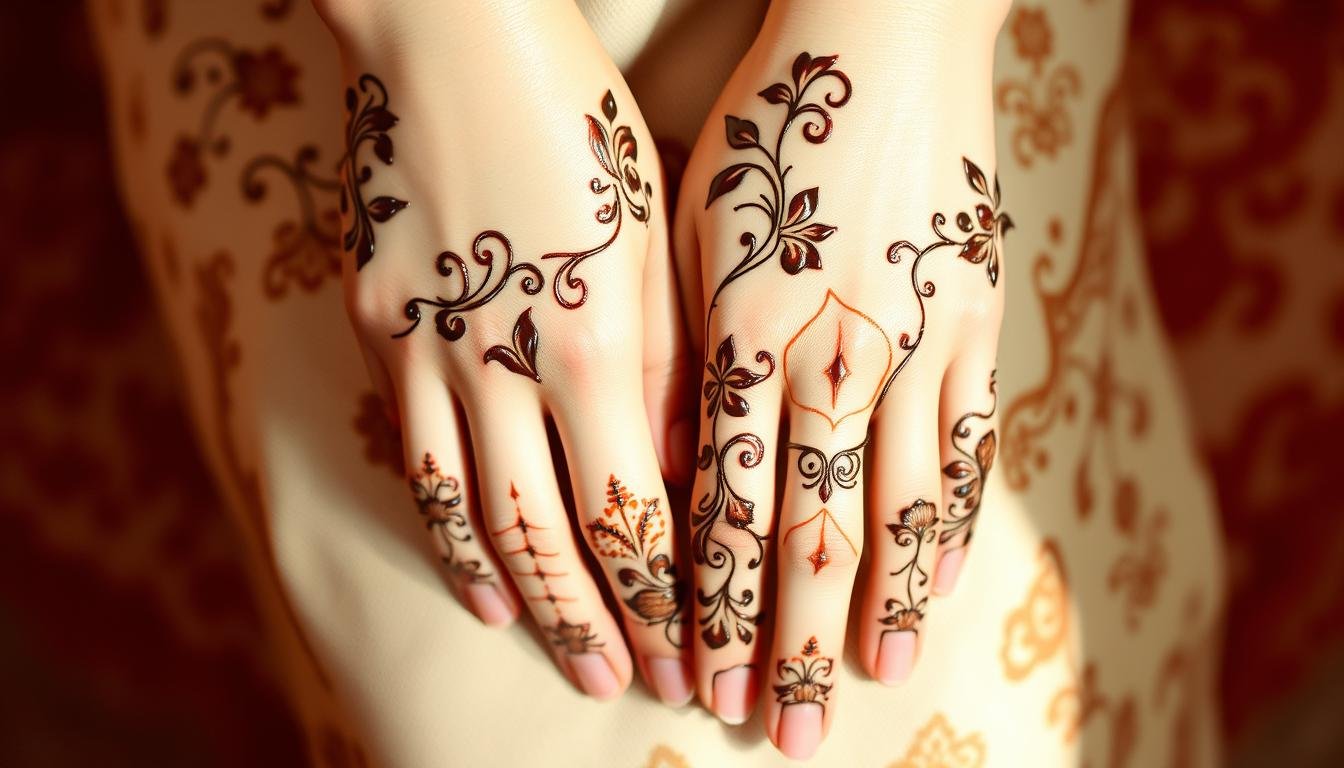Why has Moroccan henna art been loved for centuries? It’s because of its deep history and cultural importance. Moroccan henna art, rooted in Amazigh culture, has grown into a unique way to celebrate and bring good luck.
Introduction to Moroccan Henna
Exploring Moroccan henna art reveals its deep cultural value. The designs, from intricate patterns to vibrant colors, carry rich meanings. Each style, like Fessi, Marrakechi, and Meknessi, tells a story, showcasing the art’s diversity and beauty.
Key Aspects of Moroccan Henna
Key Takeaways
- Moroccan henna art has a rich history and cultural significance in Moroccan culture henna.
- Traditional henna designs are used to celebrate special occasions and symbolize good luck and protection.
- The Fessi style, Marrakechi style, and Meknessi style are popular forms of Moroccan henna art.
- Moroccan henna art is used to express love, joy, and celebration, with darker henna stains symbolizing deeper love.
- Experienced henna artists who create their own paste tend to charge higher fees compared to those who do not.
- The use of natural henna is essential to avoid severe allergic reactions and skin irritation associated with black henna.
What is Moroccan Henna Art?
Moroccan henna art is a traditional body art that uses natural henna paste. It creates intricate designs on the skin. This ancient practice has been part of Moroccan culture for centuries.
A henna art workshop is a great way to learn about this art. You can create your own unique designs.
In Morocco, henna is used for body art, hair dye, and body wash in hammams. The natural henna art form holds great cultural and spiritual value. Different designs symbolize good luck, protection, and blessings.
Definition and Overview
Moroccan henna art is known for its unique and intricate designs. These designs often adorn the hands and feet of women and girls. They are used during celebrations and cultural occasions.
The art form is highly valued for its cultural and spiritual significance. Different designs and patterns symbolize good luck, protection, and blessings.
Cultural Context
The cultural context of Moroccan henna art is deeply rooted in the country’s history and traditions. It is often used to celebrate special occasions like weddings, births, and festivals.
Different designs and patterns are used to symbolize good luck, protection, and blessings. A henna art workshop is a great way to learn about this traditional art. You can create your own unique Moroccan henna patterns using natural henna art techniques.
The History of Henna in Morocco
Henna’s history in Morocco is long and rich, dating back thousands of years. It was used by ancient Berber and Arab cultures. A Moroccan henna artist uses authentic henna techniques passed down through generations to create beautiful designs.
In Morocco, henna is more than just body art. It’s a big part of the culture, used at important events like weddings and when a baby is born. For newborn girls, henna is applied on the third day to wish them luck and blessings. This shows how important henna is in Moroccan culture, with many families growing their own henna trees.

Visiting a henna art gallery lets you see the beauty of henna designs. From traditional to modern, henna has evolved. Today, Moroccan henna artists offer many colors and designs, making it a favorite way to express culture.
The Significance of Henna in Moroccan Culture
Moroccan henna art is a key part of the country’s rich culture. Traditional henna designs mean joy, beauty, and good luck. Henna is seen as a protector and is used in big celebrations like weddings and festivals.
It’s a favorite among Muslim women for festive times. They use it to make their skin look beautiful with intricate designs. This shows the Moroccan culture henna traditions.
Henna has been a big part of Moroccan culture for centuries. The floral patterns in henna designs mean joy, happiness, and beauty. Geometric shapes stand for balance, harmony, and protection.
The henna ceremony is a big deal in Moroccan weddings. The bride and her female family members get their hands and feet decorated. This symbolizes love and fertility.
In Moroccan culture, henna is more than just body art. It connects people to their traditions and heritage. The designs show off rich regional styles and personal stories, passed down through generations.
With its deep meaning and cultural importance, Moroccan henna art is vital in the country’s traditions. It’s a big part of Moroccan culture henna heritage.
How Henna is Made
Henna comes from the Lawsonia inermis plant, used for dyeing for thousands of years. Making henna involves getting top-notch ingredients and using true henna methods. A natural henna art lover or a henna tattoo artist must know how to make the perfect henna paste.
The main color in henna is lawsone, a brown-orange compound. Henna also has natural tannins. To make the paste, henna leaves are dried and ground into powder. This powder is mixed with water or lemon juice to make the henna paste. The amount of powder to liquid changes the paste’s consistency and color.

- Sourcing high-quality henna leaves
- Drying and crushing the leaves into a powder
- Mixing the powder with a liquid to create the henna paste
- Applying the henna paste to the skin or fabric
A henna tattoo artist uses authentic henna techniques for detailed skin designs. A natural henna art fan focuses on quality ingredients for various colors and designs. Following these steps and using natural henna art methods, one can make stunning henna designs.
Common Designs in Moroccan Henna Art
Moroccan henna patterns are known for their detailed and stunning designs. These designs draw from traditional patterns and motifs. They are a big part of Moroccan culture, especially at weddings and festivals. A visit to a henna art gallery can show you the different designs and techniques used by Moroccan henna artists.
Common motifs in Moroccan henna designs include flowers, stars, and geometric shapes. These motifs are mixed to create unique and detailed patterns. The bold lines and fine details make Moroccan henna designs stand out.
Modern Moroccan henna art also exists. It brings in new motifs and techniques while keeping the traditional feel. Moroccan henna artists use various methods to make these designs, like different henna colors and patterns.
Some popular times for getting Moroccan henna patterns are:
- Weddings
- Festivals
- Births
- Religious celebrations
These events are great chances to wear beautiful henna designs. People believe these designs bring good luck and keep evil away.
Popular Occasions for Henna Application
Moroccan henna art is a big part of many celebrations and ceremonies. It shows how important traditional henna designs are in Moroccan culture. Weddings are a big time for henna, as it’s believed to bring luck and keep evil away. The designs can be very detailed, featuring paisleys, florals, and mandalas.
Henna is also a big part of festivals in Moroccan culture. It’s seen as a symbol of love, health, prosperity, and protection. This makes it a favorite for body art during celebrations. Festivals like Eid, Diwali, and Vaisakhi are when henna is often applied.
Weddings
In Islamic culture, henna is a big part of weddings, following a Sunnah practice. The “Mehndi Night” ceremony is a key event in South Asian weddings. It’s when henna is put on the bride’s hands and feet. The designs can be simple or very detailed, showing the skill in henna art.
Festivals
At festivals, henna is used to decorate hands and feet, making the atmosphere lively and colorful. Henna has become more popular in Western countries too. It’s seen as a fashion statement or temporary body art. Some festivals where henna is used include:
- Eid
- Diwali
- Vaisakhi
In summary, Moroccan henna art is key in many celebrations and ceremonies. It highlights the importance of traditional henna designs in Moroccan culture. Whether it’s a wedding or a festival, henna is a popular choice. It symbolizes love, health, prosperity, and protection.
The Role of Henna Artists in Moroccan Society
In Moroccan society, henna artists are very important. They need a lot of training and skill to make beautiful designs. A henna tattoo artist must know authentic henna techniques well to be respected. After years of practice, a Moroccan henna artist can become a true master, creating designs that are key to Moroccan culture.
Some key points about a henna artist’s role include:
- Apprenticeship and family teachings to learn the craft
- Demands of peak wedding seasons, requiring long hours and dedication
- Creation of traditional and contemporary designs, blending authentic henna techniques with modern styles
In Morocco, henna is more than just body art. It’s a big part of the culture and traditions. A henna tattoo artist is not just an artist. They are also keepers of traditions and storytellers, sharing stories and legends through their designs. With social media and tourism, Moroccan henna designs are getting more attention. This has led to a mix of old and new styles, and a growing appreciation for the art of Moroccan henna artist.
Health and Safety Aspects of Using Henna
Using henna for natural henna art requires careful thought about health and safety. Henna is usually safe, but there are risks, especially with synthetic henna. In a henna art workshop, using natural henna is key to avoid bad reactions.
Synthetic henna can lead to skin issues and allergies. About 1 in 40 people get a severe allergic reaction to p-phenylenediamine (PPD) from black henna tattoos. To have a safe and fun time with Moroccan henna patterns, pick a skilled henna artist who uses natural henna.
Important safety tips for henna use include:
* Allergic reactions to PPD or other ingredients
* Skin irritations and infections
* Scarring and long-term damage
* Interactions with certain medications or health conditions
Knowing these risks and how to avoid them lets you enjoy henna’s beauty and benefits safely.
Global Influence of Moroccan Henna
Moroccan henna art has made a big mark on global culture. Its reach goes beyond Morocco, touching Western culture and more. Traditional henna designs, with their geometric shapes and symbols, have found their way into art and fashion. A visit to a henna art gallery reveals the beauty and variety of Moroccan henna art.
Henna’s use in fashion and art is growing fast. Many designers now include traditional henna designs in their work. Moroccan henna art is also popular in body art, like tattoos and temporary tattoos. Its unique and detailed designs make it a favorite for those seeking cultural expression.
Here are some examples of Moroccan henna’s influence in Western culture:
- Henna-inspired designs in fashion and textiles
- Traditional henna motifs in modern art
- Increasing popularity of henna-based body art and temporary tattoos
The global impact of Moroccan henna art shows its beauty and importance. As the world connects more, Moroccan henna art will likely keep inspiring artists and designers worldwide.
Learning to Create Henna Art
Creating henna art takes practice and patience. If you’re new, a henna art workshop is a great place to start. These workshops teach you about Moroccan henna patterns and natural henna art techniques.
To get better at henna art, practice every day. Set aside time to work on designs and techniques. There are also many online resources like tutorials and videos to help you.
Here are some good resources for learning henna art:
- Online courses and tutorials
- Henna art books and instructional guides
- Practicing with a henna stencil kit to enhance versatility
Follow these tips and practice regularly to create stunning henna art. Whether you like traditional Moroccan henna patterns or modern designs, keep practicing and learning. Consistency is key.
Preserving the Art of Moroccan Henna
The art of Moroccan henna is loved by people all over the world. But, it faces challenges and opportunities in keeping its traditions alive. The Moroccan henna artists who have learned from their ancestors are doing their best to keep this cultural treasure real.
Safeguarding Traditional Techniques
Keeping the authentic henna techniques alive is a big challenge. Modern influences can make these traditional methods fade away. But, henna art galleries and learning programs are helping a lot to save these old practices.
Embracing Innovation
At the same time, Moroccan henna is finding ways to grow and change. Moroccan henna artists are trying new designs and materials. This keeps the art fresh and interesting for people everywhere. It’s important to keep the old traditions alive while also moving forward.




Comment (0)